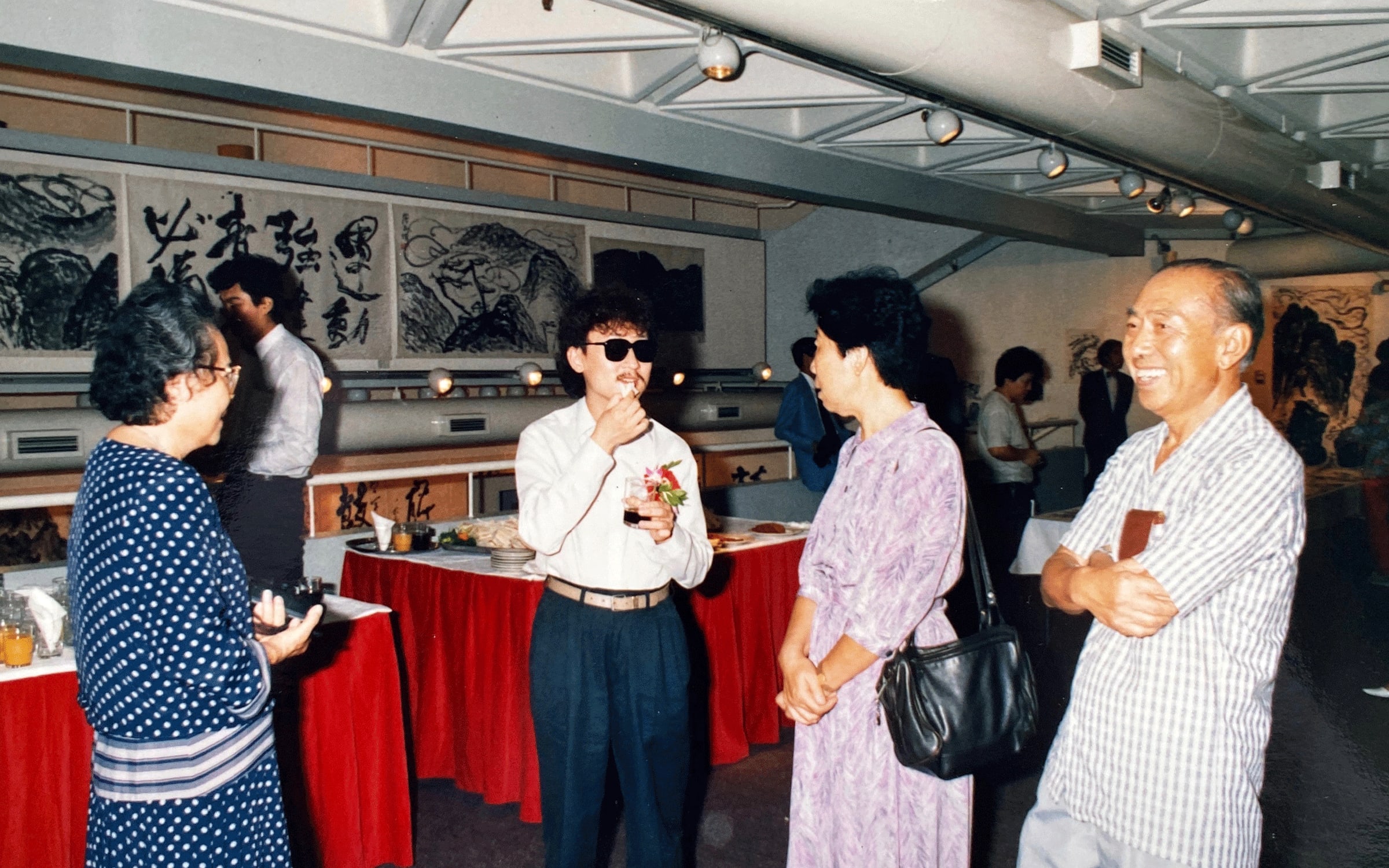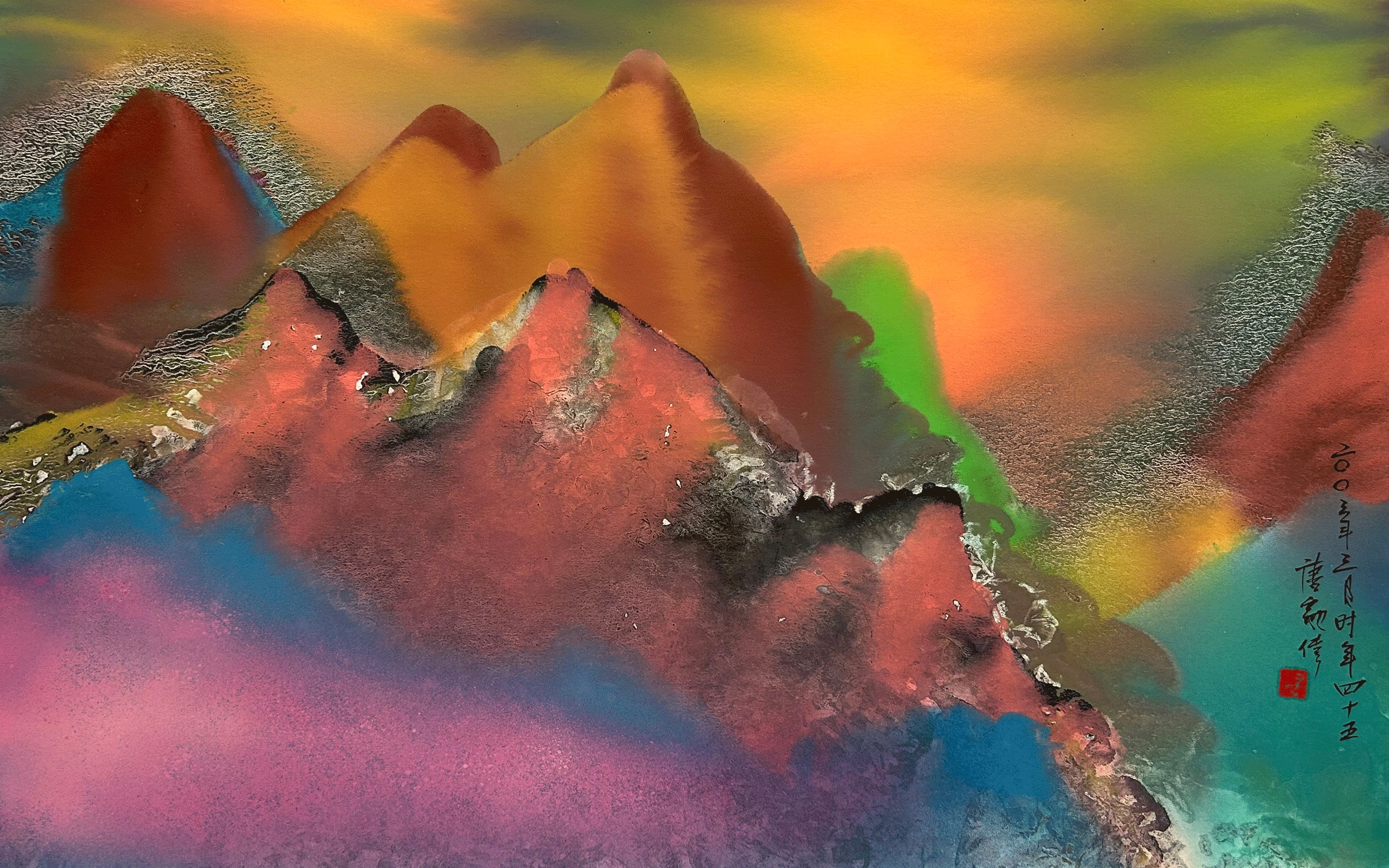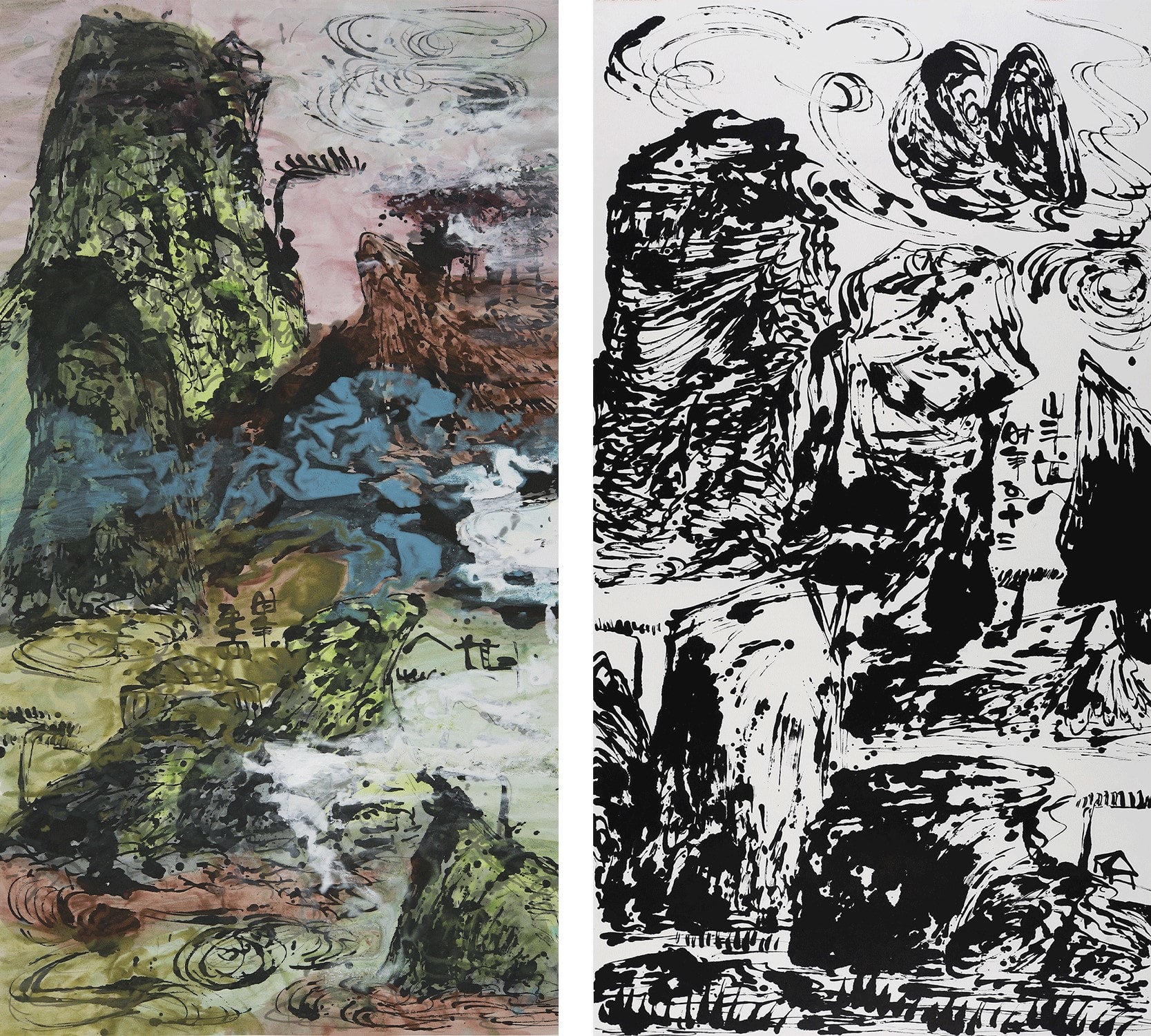I first saw Wesley Tongson’s paintings in early 2021, when I was invited to view the works by Julia White, Senior Curator for Asian Art at the Berkeley Art Museum and Pacific Film Archive (BAMPFA), where White was preparing the 2022 exhibition ‘Spiritual Mountains: The Art of Wesley Tongson’. I could scarcely believe that such a range of ink works, differing in technique and color palette, were all accomplished by the same artist. But while Tongson engaged in artistic experimentation throughout his career, he was constant in his practice of shanshui hua – Chinese landscape painting – that envisioned a transcendent world to which he could aspire.
In fact, Tongson achieved a level of mastery that went under-recognized and was largely omitted from the history of contemporary Chinese ink painting. Born in Hong Kong in 1957, he learned to use brush and ink by writing calligraphy while growing up. During his lifetime, the artist was the subject of a few solo shows in his native city, including exhibitions at Hong Kong City Hall (1985), Galerie du Monde (1986), and ‘Mountains of Heaven’ at Hong Kong Arts Centre (1992). Thanks to the continued efforts of his sister Cynthia, however, his works have become more widely exhibited internationally since his passing in 2012, and following his first retrospective, ‘Ink Explorations’, at Hong Kong Arts Centre in 2014.

When Tongson was 15, he attended high school in Canada, but his first mental health crisis prompted his return to Hong Kong, where he began receiving treatment for schizophrenia. At the age of 17, just two years after his diagnosis, he decided to pursue ink painting and began learning from private tutors. Three years later, aged 20, Tongson traveled to Canada once again, this time to study at Ontario College of Art in Toronto. While being taught Western art practices at college, Tongson continued to receive private tutelage from Gu Qingyao, a classically trained ink painter whose family originally hailed from Shanghai. Tongson also began exploring the splash ink techniques of 20th-century master Zhang Daqian, whose modernist approach would influence an international audience through his travels to Europe and the Americas after he left China in 1949.
Unsurprisingly, since Pablo Picasso was a great admirer of Zhang’s work, Tongson closely studied Picasso’s approach to abstraction. Both artists’ influences shine through in Tongson’s works from different stylistic periods. In the series ‘Mountains of Heaven’ (late 1980s–2004), for instance, Tongson’s emulation of Zhang’s splash ink is evident in vivid pigments of bright pink, jade green, azurite blue, and burnt sienna that feather against black-and-white renderings of mountains. While in the ‘Spiritual Mountains’ series (2009–12), monochromatic mountain peaks, such as the one featured in the upper central section of Spiritual Mountains No. 621 (2011), speak to Picasso’s influence in Tongson’s use of abstraction to tilt the pictorial plane.
Upon his return to Hong Kong in 1981, Tongson studied for a year with the renowned Hong Kong ink painter Harold Wong, as the only pupil he ever took. Through Wong, Tongson continued his education in classical ink painting and gained knowledge of Chinese masterworks. Most notably, Wong’s influence comes through in Tongson’s careful study and control of ink tonality, as seen in Untitled (1997), which offers fluid, gray-toned shapes that seem to merge with and emerge from each other. He also enrolled in a month-long workshop with the Taiwanese Fifth Moon Group co-founder Liu Guosong, who encouraged his students to experiment with ink, brush, and paper in unconventional ways. The influence of both Wong and Liu come through in Tongson’s experimental work Untitled (2001). Composed of marbled and splashed ink to capture the texture of a rockface, Untitled creates a topographical rendition of a mountain that leaves neither empty space nor any hint of sky.

As early as his 1992 exhibition at Hong Kong Arts Centre, Tongson was exploring the possibilities of transcending the human realm through painting. Many of the artist’s works from this period included direct references to Buddhism and Christianity. Boundless Compassion (1993), for instance, layered Buddhist phrases about kindness in gestural calligraphy onto marbled and splashed ink in hues of grey, blue, green, and red. Tongson, according to his personal notes, saw art as a means of liberating himself from his mental health struggles. To make a work, he would first place a blank canvas on a table and walk around it until he was ready to transpose the image that came into his head.
The heavenly worlds the artist visualized through this meditative process were often illuminated by what he called ‘Tongson Colors’: bright pigments of splashed ink that expanded Chinese painting’s traditional use of blue and green to depict otherworldly utopias with the incorporation of warm-toned colors like orange and red. Scudding Clouds, Misty Peaks (1996) is defined by the stark contrast between the solid, weighty mass of the mountains and the light washes of sapphire; while Mountains of Heaven No. 226 (2003) can be seen as a further development of the ‘Tongson Colors’ with its combinations of phosphorescent pinks, greens, blues, and dark oranges increasingly overtaking solid mountain forms.

As his distinctive artistic style developed, however, Tongson’s mental health deteriorated. While he found solace in his practice, noting how he could rely on painting and calligraphy to keep him company during difficult times, the prolonged use of medication to treat his schizophrenia eventually took a physical toll. In a letter to his doctor, dated June 19, 2000, Tongson’s mother expressed concerns about his medication, which made him sleep far longer than normal and diminished his interest in doing anything. ‘Have to remember I am delicate,’ Tongson wrote nearly a decade later, in a personal note to himself. ‘If I hurt myself and cannot even do a six-feet painting, I will be miserable.’ By then, the artist had abandoned color to concentrate on creating monochrome works with his hands, fingers, and nails.
Despite this shift in palette and technique, the shanshui subject matter and the goal to achieve a state of peace remained a constant in Tongson’s monochromatic finger paintings – a selection of which will be on view as part of Galerie du Monde’s Kabinett presentation at Art Basel Hong Kong in 2023. Having researched the compositional approaches of Zhu Da (also known as Bada Shanren), Hong Ren, Kuncan, and Shitao – four eminent 17th-century monk painters of the late Ming to early Qing dynasties – Tongson wholeheartedly believed that the combination of Buddhism and art could elevate his practice to a higher level of consciousness. Manipulating pictorial plains and employing expressive brushstrokes to reflect their disillusionment with contemporary society, these four ‘eccentric’ artists offered an alternative to the orthodox landscape paintings that would come to dominate the Qing dynasty. Likewise, for Tongson, applying paint directly with his hands was a vital element in his quest to express his innermost feelings and aspirations, foregoing any instruments that stood between his vision of a transcendent realm and the surface of the painting.
Created in the three years prior to his death, the ‘Spiritual Mountains’ series reveals Tongson’s mastery of the viscosity of his chosen material, with his ability to swipe ink dexterously across monumental compositions into sinews making a contemporary nod to the hemp fiber strokes of the 14th century Song dynasty painter Huang Gongwang. While many of the ‘Spiritual Mountains’ paintings are monochromatic, several large-scale works bear the luminescent ‘Tongson Colors’ which defined the bright, tranquil landscapes that brought him so much solace earlier in his career – reflecting a serenity for which he never stopped searching.
Wesley Tongson’s work will be presented by Galerie du Monde in the Kabinett Sector at Art Basel Hong Kong 2023.
Yi Yi Mon (Rosaline) Kyo is an Assistant Professor of Art History and Chinese Studies at Davidson College, North Carolina.
Published on February 28, 2023.
Caption for full-bleed images, from top to bottom: 1. Wesley Tongson 唐家偉, Mountains of Heaven No. 226, 2003. Courtesy of Wesley Tongson Charitable Trust and Galerie du Monde. 2. Wesley Tongson 唐家偉, Untitled, 2001. Courtesy of the Berkeley Art Museum and Pacific Film Archive. 3. Wesley Tongson 唐家偉, Untitled, 1997. Courtesy of the Berkeley Art Museum and Pacific Film Archive.